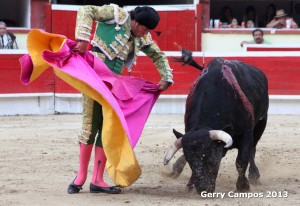Modest Cartel Offers Surprises

Low expectations can work wonders on actual results. The 3rd corrida of the maiden season directed by the Casa Toreros management group was a case in point. Having presented 6 of Mexico’s frontline toreros and 2 acceptable encierros of bulls from similarly prestigious ranches in the first 2 corridas of the year, it was clearly time to return some favors, extend an olive branch and appease the mostly neophyte public with a more accessible brand of toreo. Never the less, the corrida offered some pleasant surprises.
A herd of morphologically challenged bovines from the new/old ranch of Monte Cal-dera were presented for the resurrection of Ismael Gomez, “Mayito”, perhaps Tijuana’s biggest taurine tease of the last 50 years, the “tapatio” Alfredo Rios, “El Conde”, and the raw athleticism and youthful chutzpah of Antonio Garcia, “El Chihuahua”. Perhaps fearing the modest card would disproportionately affect the gate, Casa Toreros offered a generous array of promotions (2×1 in sunny side, reduced prices for seniors, children under 12 free with paying adult). This produced the third acceptable crowd in three tries—a success of enormous merit by itself; the corrida is once again becoming a cultural and social reference point in Tijuana.
Mayito’s career erupted nearly 25 years ago with historic triumphs in important plazas across the republic, and evaporated almost as quickly. The telegenic Tijuanense has been sporadically active in the interim, but hadn’t made a meaningful appearance in over five years before Sunday’s action. Even though he enjoyed the unconditional support of his hometown fans from his first appearance in the Plaza (he was nearly late for the opening parade trying to acknowledge the base), his performance was clearly an exercise in nostalgic good intentions than any discovery of current capacity. He was not bad—his bulls didn’t overpower him and there were—very—isolated moments of adequate work, enough for the paisas to have awarded him a nostalgic ear, except for his unfortunate sword work. However, if his bull’s horns had been as formidable as their ears, Mayito would have been contemplating his future from a hospital bed instead of his living room. Kudos to Casa Toreros for the inspiration…
Alfredo Rios, “El Conde”, is another torero in the line of the younger, more popular “El Zapata”; technically capable, occasionally inspired, perhaps too quick to appease the public taste for the spectacular instead of the greater resonance of classical work—and whose best days are lost in the miasma that was Mexican toreo in the 90s and early 2000s. His work with “Aventurero”, run in 5th place, was, by far, the most satisfying and complete of the day. A quite of rhythmic, gyrating “orticinas” was followed by 3 very good banderilla placements—the last especially giving all the advantages to the bull—and a satisfying combination of crowd pleasing tremendismo and solid craft. Two smooth, slow derechazos and two circular dosantinas preceded an almost instantaneously effective—but overly bloody—final sword. Two somewhat generous ears were cut.
Conde’s first bull might have been good as well except for a terrible pic given by the horseman who was ambushed by the unusually violent charge of the bull as he entered the ring.
Antonio Garcia, “El Chihuahua” is a classic example of youthful desire and disregard for potential consequences overcoming technical limitations. His first bull, “Cielo Rojo” was a bull for a great triumph, de lio gordo in the argot—brave, strong, noble but not easy, jealous to pursue a correctly offered lure, one of the best bulls of the year to date. Also poorly treated by the picador, his spectacular attacks during the act of the banderillas, coupled with “Chihuahua”’s undeniable mastery of this skill, produced what could well have been the most spectacular pairs in the last 50 years. The crowd reaction was so instantaneous and authentic that “Chihuahua” was obligated to take a triumphant turn of the ring before continuing.
Unfortunately, the exasperating jumble of work that preceded, and followed, the electric placements, only served to highlight how much “Chihuahua” has to learn. One can only imagine what could have transpired had the excellent chestnut fallen to the expertise of a Zotoluco or Payo, or Conde… it may be a long while before Garcia sees another bull the likes of “Cielo Rojo”. Luckily for Chihuahua, there was enough residual good will that he was able to cut an ear of the last animal of the day, following an equally up and down performance which captured the enthusiasm of the public.
Unmet potential—both human and animal—aside, the 3rd corrida continued the very positive trend of respectable, consistent, diverse and enthusiastic crowds, and a sense of the corrida as a destination event.






